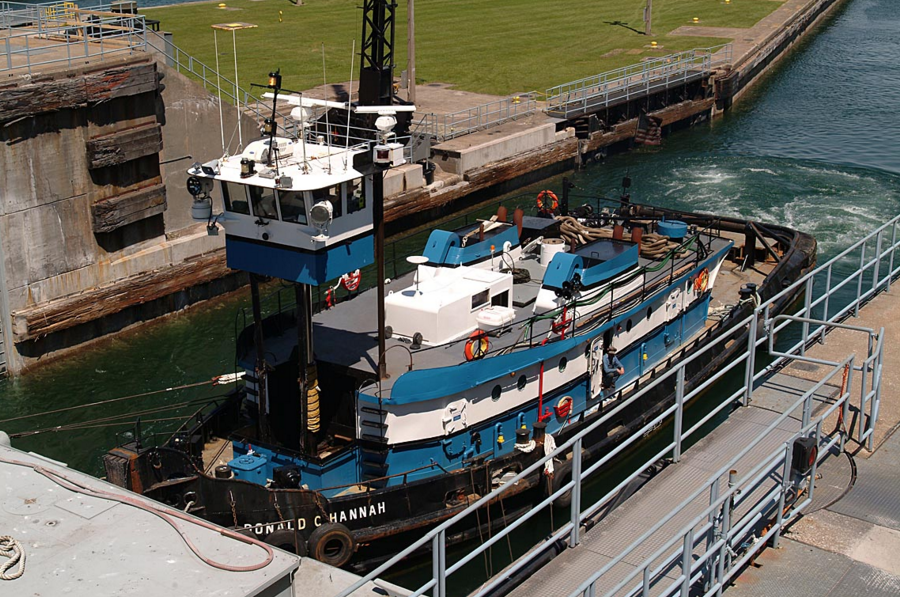Shipping and Logistics

No Delays for Great Lakes Shipping Season
Written by Sandy Williams
March 13, 2016
The Great Lakes 2016 shipping season commenced on March 2 with a load of iron ore for ArcelorMittal Cleveland. The tug/barge Dorothy Ann/Pathfinder loaded 14,600 tons of iron ore at the Cleveland Bulk Terminal to deliver to ArcelorMittal on the Cuyahoga River.
The barge was about 4,600 tons shy of a full load due to silt build-up on the Cuyahoga that reduces vessel draft. Dredging of the Cuyahoga River will begin in mid-May by the U.S. Army Corps of Engineers.
The Joseph L. Block is expected to load 34,000 tons of iron ore at Escanaba, Mich., on March 16 for delivery to Indiana Harbor.
The Lake Carriers Association (LCA) reports this is the first time in several years that weather conditions allowed dry-bulk cargo to continue all winter on Lake Michigan. Lake Superior ice was light this year with coverage on the lake at 2.4 percent as of March 12 compared to 76.7 percent in 2015.
Ice coverage on the Great Lakes system is currently 6 percent compared to 66.5 percent a year ago, according to data from GLERL/NOAA. The mild El Nino winter minimized ice formation on the lakes during the past winter.
The official shipping season begins with the opening of the Soo Locks on March 25 which should go smoothly with the mild temperatures. The U.S. and Canadian Coast Guard will tackle any ice formation on the St. Mary’s to clear access to the Soo Locks.
Ore tonnage down on Lakes
LCA reported that U.S. Great Lakes cargo tonnage fell 3 percent to 87.2 million tons in 2015. The decrease was largely due to 10.4 percent decline in iron ore cargos. At 40.9 million tons, iron ore shipments on the Great Lakes were at their lowest level since 2009.
Wrote LCA in a recent press release: “The iron ore trade was down more than 10 percent because of record levels of foreign steel being dumped into the U.S. market, but legislation recently signed by President Obama, the Trade Facilitation and Trade Enforcement Act of 2015, promises to reign in tariff evasion and other unfair trade practices. In total it takes more than two tons of iron ore, fluxstone and other Lakes-delivered raw materials to make a ton of steel, so restoration of fair trade in steel is key to the future of Lakes shipping.”
Poe Lock study forecasts potential catastrophe

The study, titled “The Perils of Efficiency: An Analysis of an Unexpected Closure of the Poe Lock and its Impact,” looks at the catastrophic consequences of a six-month failure of the 47-year-old lock. According to Homeland Security, a failure of the lock would cripple the U.S. economy. The report calls the Poe Lock “the Achilles’ heel of the North American industrial economy.” The key findings of the report are as follows:
– One the Nation’s most economically vital systems, the iron mining-integrated steel production – manufacturing supply chain, is also potentially the least resilient.
– A disruption of the Poe Lock likely will cause an almost complete shutdown of Great Lakes steel production.
– A shutdown of Great Lakes steel production likely will cause almost all North American appliances, automobile, construction equipment, farm equipment, mining equipment, and railcar production to cease within weeks.
– The disruption would likely result in widespread bankruptcies and dislocations throughout the economy.
– Almost 11 million people would likely be unemployed because of the impact and the North American economies would likely enter a severe recession.
According to the report, Michigan, Indiana, and Ohio would suffer the highest unemployment rates followed by Kentucky and Tennessee. California, Illinois, New York and Texas are estimated to lose more than 500 jobs each.
The smaller, 73-year-old McArthur Lock was down for emergency repairs in summer of 2015 for 20 days. According to LCA, the closure resulted in the delay of nearly 2 million tons of cargo.
Congress has authorized twice the building of a second Poe-sized lock at the Soo Locks but construction was never started due to lack of funding because of a flawed analysis of the project’s benefit/cost ratio.
The U.S. Army Corps of Engineers found that the analysis erroneously assumed freight moved on the Lakes had unlimited access to alternative transportation by train and truck. Research by the Corps proved that that trains and trucks would be inadequate to fill the void if the Poe Lock should fail. The Corps will take the DHS report into account in conducting an economic reevaluation concerning the Soo Locks.

Sandy Williams
Read more from Sandy WilliamsLatest in Shipping and Logistics

Trump signs executive order aimed at making US shipbuilding ‘great again’
President Trump on Wednesday signed an executive order meant to breathe new life into American shipbuilding and curb Chinese dominance in the sector.

Great Lakes iron ore trade fell again in March
Recall that shipments also saw a sharp decline in January.

Longshoremen ratify contract with maritime alliance
Nearly 99% of ILA members voted in favor of a new labor deal with the United States Maritime Alliance that covers workers at ports on the Atlantic and Gulf coasts.

Reibus: Flatbed rates up slightly but uncertainty ahead
With construction seasonally soft, the flatbed market remains softer than the other main trailer types.

US-flagged ore shipments on Great Lakes down in 2024
The Lake Carriers’ Association reported a 4.5% y/y decline in December’s ore shipments of 4.6 million short tons.

